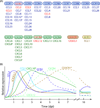Inflammatory reaction after traumatic brain injury: therapeutic potential of targeting cell-cell communication by chemokines
- PMID: 25979813
- PMCID: PMC4485943
- DOI: 10.1016/j.tips.2015.04.003
Inflammatory reaction after traumatic brain injury: therapeutic potential of targeting cell-cell communication by chemokines
Abstract
Traumatic brain injury (TBI) affects millions of people worldwide every year. The primary impact initiates the secretion of pro- and anti-inflammatory factors, subsequent recruitment of peripheral immune cells, and activation of brain-resident microglia and astrocytes. Chemokines are major mediators of peripheral blood cell recruitment to damaged tissue, including the TBI brain. Here we review the involvement of specific chemokine pathways in TBI pathology and attempts to modulate these pathways for therapeutic purposes. We focus on chemokine (C-C motif) ligand 2/chemokine (C-C motif) receptor 2 (CCL2/CCR2) and chemokine (C-X-C motif) ligand 12/chemokine (C-X-C motif) receptor 4 (CXCL12/CXCR4). Recent microarray and multiplex expression profiling have also implicated CXCL10 and CCL5 in TBI pathology. Chemokine (C-X3-C motif) ligand 1/chemokine (C-X3-C motif) receptor 1 (CX3CL1/CX3CR1) signaling in the context of TBI is also discussed. Current literature suggests that modulating chemokine signaling, especially CCL2/CCR2, may be beneficial in TBI treatment.
Keywords: CCR2; chemokines; inflammation; traumatic brain injury.
Copyright © 2015 Elsevier Ltd. All rights reserved.
Figures



References
-
- Faul M, et al. Traumatic Brain Injury in the United States: Emergency Department Visits, Hospitalizations and Deaths 2002–2006. Centers for Disease Control and Prevention. National Centers for Injury Prevention and Control. 2010
-
- Teasdale G, Jennett B. Assessment of coma and Impaired consciousness: A practical scale. Lancet. 1974;304(7872):81–84. - PubMed
-
- Draper K, Ponsford J. Cognitive Functioning Ten Years Following Traumatic Brain Injury and Rehabilitation. Neurophyschology. 2008;22(5):618–625. - PubMed
Publication types
MeSH terms
Substances
Grants and funding
LinkOut - more resources
Full Text Sources
Other Literature Sources
Research Materials
Miscellaneous

